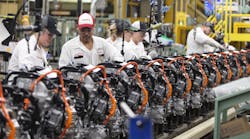Editor’s note: Welcome to So That Happened, our editors’ takes on things going on in the manufacturing world that deserve some extra attention. This will appear regularly in the Member’s Only section of the site.
A tinny sound
We’re thinking Cleveland-Cliffs Inc. Chairman, President and CEO Lourenco Goncalves and his close partners at the United Steelworkers will want a better outcome of their pursuit of U.S. Steel Corp. than it appears they’ll get from their push to have the U.S. Department of Commerce impose heavy tariffs on foreign competitors’ tin mill products.
Cliffs and the USW early this year petitioned Commerce Department officials to impose duties on tin mill goods—think cans used in first and foremost in food packaging—from producers in Canada, China, Germany, the Netherlands, South Korea, Taiwan, Turkey and the United Kingdom. Accusing their foreign peers of dumping their products on the United States rather than curtailing production, they were seeking tariffs of up to 300%.
Commerce investigators didn’t see things that way after poring over the numbers: The agency last week said imports from Korea, the Netherlands, Taiwan, Turkey and the U.K. aren’t being dumped. Those from China, they said, have a dumping rate of 122% (a number that includes a related case looking into Chinese subsidies) while imports from Canada and Germany should be hit with tariffs of only about 5% and 7%, respectively.
David Chavern, president and CEO of the Consumer Brands Association trade group, hailed the decision as a win for U.S. consumers and is crossing his fingers that his members—which include Campbell Soup Co., Procter & Gamble Co. and a host of other blue-chip names—will be even happier when the government issues its final ruling in this case in January.
“We are encouraged that our message was heard: Ordinary people will inevitably bear the costs of new tariffs on tin mill steel through higher food prices and lost jobs,” Chavern said in a statement, adding that he hoped further analysis would show “that there is no reason to justify even these marginal tariffs on Canada and Germany.”
Goncalves and the Cliffs didn’t respond to Commerce’s initial ruling last week. USW International President Tom Conway called the decision a step in the right direction.
“If we don’t curtail this dumping now, it will eventually choke out our domestic industry, leaving us with no alternative but to rely on foreign goods,” Conway said. “We saw how dangerous that dependence was during the pandemic, and we must be proactive now.”
Multilingual Learning Library
OSHA has estimated that language barriers contribute to a quarter of all work accidents, so Vector Solutions has released foreign language translation libraries for over 900 industrial training courses to support a safer environment for the multilingual workforce.
The human-translated training can provide a more nuanced approach than AI-generated translations, promoting a proper understanding of the safety, operations and maintenance procedure trainings. Available languages include Arabic, Chinese, Czech, French, German, Italian, Polish, Portuguese, Korean, Swedish, Thai and more.
"Access to effective, understandable training is crucial for continued employee safety in the industrial sector and beyond," said Vector Solutions’ Vice President of Content Michael Ojdana. "Vector Solutions' foreign language libraries make it easier for businesses with a multilingual workforce to maintain OSHA standards and better protect the health and safety of their employees."
The Site Formerly Known as Peloton Output Park
Last week I drove past the site formerly known as Peloton Output Park in Troy Township, Ohio. Announced in May 2021, the location would house more than 1 million-square-feet of manufacturing, office and amenities space, the fitness company said at the time. Production was expected to begin in 2023.
That didn’t happen, of course. The company announced in early 2022 that plans for Peloton Output Park were kaput, and at the same time said it would change CEOs, make dramatic job cuts and downsize overall. Moreover, just a few months later, Peloton reported it would cease manufacturing its own bikes altogether, outsourcing them to a manufacturing firm with which it had an existing relationship.
Prior to last week, I had not seen the Peloton manufacturing site since its ground-breaking ceremony in August 2021. As you might expect, all that existed then was a wide-open space being prepped for construction. The view was significantly changed during this more recent look. I was in that area on my return to Cleveland from a plant visit, so I decided to take a slight detour out of sheer curiosity.
There’s a significant structure where once was mud, and fencing surrounds the building. It was pouring rain during my visit, which hindered my ability to observe anything more – although I’m not sure there was anything more to observe.
Today was Peloton’s quarterly earnings call. I dropped in to hear whether any updates about the sale (or other disposition) of that property would be shared, and none was provided. The company reported a net loss of $242 million in the fourth quarter of fiscal 2023 and shared a lot of plans its leaders hope lead to a turnaround. None of those plans include manufacturing its own products.
The company also released a shareholder letter signed by CEO Barry McCarthy. In it he “reaffirms” goals he outlined in February, which include selling Peloton’s Ohio facility. I’ll be keeping an eye out for that eventuality, but otherwise am likely to put Peloton in my rear-view mirror in terms of regularly reviewing what the company is up to. I cover manufacturing. Peloton doesn’t manufacture.
That said, I did get a specific chuckle from a line in the shareholder letter. It reads: “For the last ten years Peloton has been the Henry Ford of stationary bikes. We sold any color bike frame you wanted as long as you wanted black.”
Henry Ford! It’s hard to walk away from manufacturing.
At Least Our Smart Robot Overlords Won’t Be Flying Much
Drone enthusiasts, weep. Supply chain logistics favors smart mobile robots. So, if you’re interested in working with autonomous machines, put down the control sticks and learn some new software.
Technology and research firm Gartner last week released a new report on drone and smart robot adoption for logistics and warehousing operations. Within the next three years, Gartner says, smart robot adoption will far outpace use of drones.
Autonomous mobile robots (AMRs) have become so user-friendly and affordable that even small businesses can adopt the technology. It’s not just for traditional logistics, either. AMRs in particular see use right on the shop floor, moving goods from station to station or transporting materials through the plant.
Drones, on the other hand, argues the report, will be deployed for more targeted, specific use cases like inspections and remote deliveries.
Gartner places smart robots near the “peak of inflated expectations” on the hype cycle chart, meaning high expectations are still the norm for the technology but also that the end is nigh for speculation and dreaming. Or, to put it another way, people are finally figuring out what smart robot technology is actually good for.
The report argues that therefore by 2027 most companies deploying robotics will have diverse fleets of hundreds or thousands of robots that carry out a wide range of tasks, thanks in part to the rise of new multiagent orchestration (MAO) software that makes onboarding robots faster than ever.
A New Fit for Hondas
Uniforms that are sent to Aramark and Cintas to wash are evaluated to determine whether they’re ready for retirement, and those that meet the criteria are sent to Leigh Fibers, a supplier that shreds the uniforms into the fiber grade required for vehicle insulators. Next the material heads to another supplier, UGN, which further processes the fibers and molds it into insulation.
Thus far, 380,000 pounds of clothing has been recycled from 45,000 uniforms. The material is used in five insulator parts.
What’s next in the vehicle ready-to-wear portfolio? We propose a Thredup-type service where you can raid your closet, then customize your next car with that pair of striped satin pants that made you look like a reject from an Aerosmith cover band—but would look great as trim on your dashboard.




